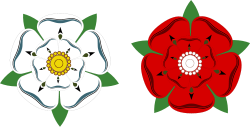Battle of Northampton (1460)
| Battle of Northampton | |||||||
|---|---|---|---|---|---|---|---|
| Part of the Wars of the Roses | |||||||
 |
|||||||
|
|||||||
| Belligerents | |||||||
|
|
|
||||||
| Commanders and leaders | |||||||
|
|
|
||||||
| Strength | |||||||
| unknown | unknown | ||||||
| Casualties and losses | |||||||
| unknown | 300 killed | ||||||
The Battle of Northampton was fought on 10 July 1460 near the River Nene, Northamptonshire. It was a major battle of the Wars of the Roses. The opposing forces were an army led by nobles loyal to the King Henry VI of the House of Lancaster, his Queen Margaret of Anjou and their seven-year-old son Edward, Prince of Wales on one side, and the army of Edward, Earl of March and Warwick the Kingmaker on the other.
After the disintegration of the Yorkist army at Ludford Bridge in 1459, many of the Yorkist commanders went into self-imposed exile. The Duke of York and his second son Edmund, Earl of Rutland, retired to the relative safety of Dublin, Ireland. His principal supporters the Earl of Warwick and his father the Earl of Salisbury, and York's son Edward, Earl of March reached Calais on 2 November 1459, where Warwick found his uncle Lord Fauconberg. In England, the Lancastrians were quick to exploit the Yorkist flight. The Earl of Wiltshire was appointed Lieutenant of Ireland and the Duke of Somerset became Captain of Calais. Neither however succeeded in occupying their new posts as the Irish refused to dislodge York and the gates of Calais remained firmly closed to their new 'Captain'.
...
Wikipedia
